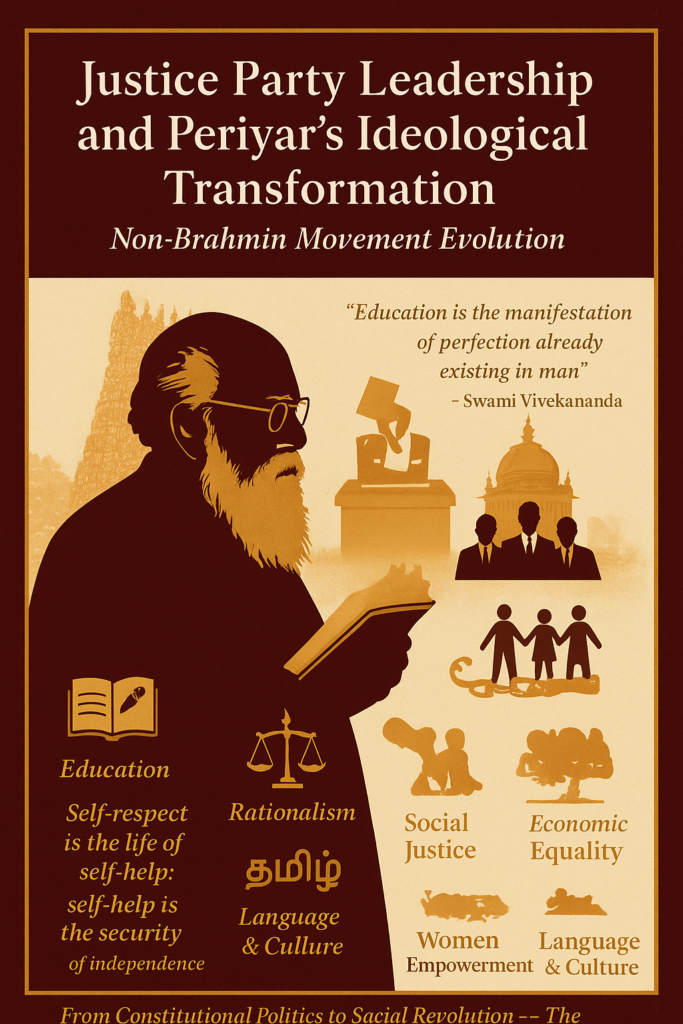
Justice Party Leadership and Periyar’s Ideological Transformation: Non-Brahmin Movement Evolution
“Education is the manifestation of perfection already existing in man” – Swami Vivekananda
I. Early Justice Party Approach (1916-1925)
Constitutional Liberalism Framework
- Founding Vision: Dr. T.M. Nair, P. Theagaroya Chetty establishing political platform for non-Brahmin representation
- Administrative Focus: Seeking proportional representation in government services, educational institutions
- Elite Leadership: Professional politicians, lawyers, landlords pursuing constitutional remedies
- Moderate Methodology: Working within colonial framework, petitioning government, electoral participation
Early Achievements
- Government Representation: Communal G.O. (1921) reserving posts for non-Brahmins
- Educational Reforms: Establishing colleges, promoting vernacular education
- Economic Policies: Agricultural reforms, cooperative societies, industrial development
- Political Success: Winning 1920, 1923 elections, forming ministries under dyarchy
II. E.V. Ramasamy’s Revolutionary Ideology
Rationalist Philosophy
- Religious Critique: Attacking Hindu orthodoxy, Brahminical supremacy, caste system theological foundations
- Scientific Temper: Promoting rational thinking, questioning superstitions, empirical approach to social problems
- Anti-Puranic Campaign: Rejecting Ramayana, Mahabharata as Aryan-Brahmin propaganda tools
- Atheistic Worldview: “There is no God” slogan challenging religious authority
Social Revolution Vision
- Gender Equality: Women’s liberation, education, property rights, divorce rights advocacy
- Caste Annihilation: Inter-caste marriages promotion, anti-Brahmin demonstrations, temple entry movements
- Language Pride: Tamil linguistic nationalism, anti-Hindi campaigns, Dravidian cultural assertion
- Economic Justice: Land redistribution, agricultural labor rights, industrial worker welfare
“Self-respect is the life of self-help; self-help is the security of independence” – E.V. Ramasamy
III. Integration Process and Synthesis
Self-Respect Movement Merger (1925-1944)
- Leadership Transition: Periyar becoming Justice Party President (1938), ideological direction shift
- Organizational Integration: Self-Respect Movement activists joining Justice Party structure
- Programmatic Fusion: Constitutional politics combined with social revolutionary agenda
- Mass Base Expansion: Moving beyond elite leadership to grassroots mobilization
Ideological Synthesis
- Political Representation + Social Transformation: Electoral success supporting radical social reform
- Constitutional Methods + Mass Movements: Parliamentary participation with street demonstrations
- Regional Autonomy + Cultural Revolution: Dravidian state demand with social engineering
- Economic Development + Social Justice: Industrial progress with caste equality
IV. Strategic Evolution and Impact
Methodological Transformation
- From Constitutional to Confrontational: Early petitioning replaced by direct action, protests
- Elite to Mass Leadership: Professional politicians joined by social activists, reformers
- Sectoral to Comprehensive: Administrative representation expanded to total social transformation
- Regional to Pan-South: Tamil Nadu focus extended to Dravidian movement across South India
Accelerated Social Reforms
- Anti-Caste Marriages: State encouragement, legal support, social acceptance promotion
- Educational Revolution: Rationalist curriculum, scientific education, critical thinking emphasis
- Religious Radicalization: Temple entry campaigns, Hindu ritual criticism, atheistic propaganda
- Women’s Empowerment: Political participation, professional careers, domestic equality
Long-term Movement Impact
- Comprehensive Change Agenda: Beyond political representation to civilizational transformation
- Ideological Clarity: Clear anti-Brahmin, pro-Dravidian, rationalist identity formation
- Organizational Strength: Disciplined cadre, mass following, sustainable institutional structure
- Political Legacy: DMK, AIADMK emergence as dominant Tamil Nadu political forces
“The Tamil language is our mother, Tamil Nadu our motherland” – Periyar
Conclusion
The integration of Justice Party’s constitutional liberalism with Periyar’s revolutionary ideology transformed the non-Brahmin movement from elite political representation to comprehensive social transformation. This synthesis created sustained mass movement combining electoral success with radical social reform, establishing foundations for modern Tamil Nadu’s progressive politics emphasizing social justice, rationalism, and Dravidian cultural pride.
Post Views: 518
